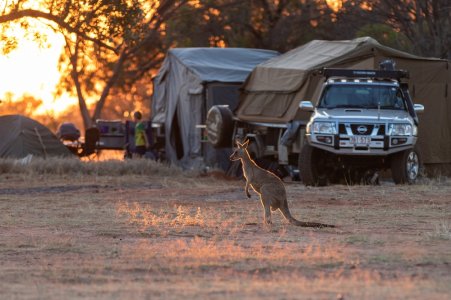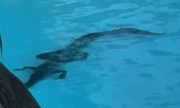Hit a Kangaroo? Here's the Ultimate Guide to What You Should (And Absolutely Should NOT) Do Next!
By
Seia Ibanez
- Replies 8
Navigating the roads of the Australian Capital Territory (ACT) can sometimes feel like a journey through a wildlife park, with kangaroos frequently making unexpected appearances. While these encounters can be a charming reminder of Australia's unique fauna, they can also lead to accidents that leave both drivers and kangaroos in distress. If you find yourself in the unfortunate situation of having hit a kangaroo or come across one that has been injured, it's crucial to know the appropriate steps to take.
The ACT is known for its high number of vehicle-animal collisions, and despite the best intentions, many people are unsure how to respond when faced with an injured kangaroo. The story of Fiza Khan Pye, who witnessed a kangaroo being hit by a vehicle, highlights the confusion and emotional turmoil that can ensue. She watched helplessly as the injured animal struggled with a shattered leg, and despite her efforts to seek help, she encountered delays and uncertainty about the correct course of action.
When dealing with injured wildlife, the first and most important rule is to avoid approaching or touching the animal. Kangaroos, even when injured, can be unpredictable and potentially dangerous. Your safety and the welfare of the animal are paramount. Instead, the best thing to do is to call Access Canberra on 13 22 81. Provide as much detail as possible about the location and condition of the kangaroo, as this will help rangers prioritize their response.
Access Canberra operates a triage system to dispatch ACT Parks rangers to incidents based on urgency. While it can be distressing to leave an injured animal, sometimes it's the kindest option. Rangers are trained to handle these situations and will assess whether the kangaroo can recover naturally or if it requires euthanasia due to significant injuries and welfare concerns.
If you're faced with a long wait for a ranger, resist the urge to intervene. Michaela Watts, ACT Parks executive branch manager, emphasizes the importance of trusting the professionals. Rangers are equipped to manage the situation safely and ethically.
One aspect of kangaroo rescue that often goes unnoticed is the fate of joeys. Rangers will check an injured kangaroo's pouch for joeys and assess their viability. In the ACT, joeys can be cared for by local carers for up to 48 hours before being transferred to New South Wales, where they can be rehabilitated and released. This cross-border cooperation is essential, as the ACT has strict policies regarding the rehabilitation of eastern grey kangaroos due to conservation management priorities.
The debate over these policies is ongoing, with organizations like Save Canberra's Kangaroos advocating for change. They argue for better protections for kangaroos, including the ability for local wildlife carers to rescue and rehabilitate them. Community pressure and awareness can play a significant role in shaping these policies.
In the meantime, if you hit a kangaroo or come across one that's been injured, remember these key points:
1. Do not approach or touch the kangaroo.
2. Call Access Canberra on 13 22 81 immediately.
3. Provide detailed information about the animal's condition and location.
4. Wait for rangers to arrive; do not attempt to intervene.
5. Understand that rangers will assess the situation and act in the best interest of the animal's welfare.
 By following these guidelines, you can ensure that you're doing the right thing for the kangaroo, yourself, and the broader ACT community. It's a delicate balance between human activity and wildlife conservation, but with the right knowledge and actions, we can coexist peacefully with our iconic marsupial neighbours.
By following these guidelines, you can ensure that you're doing the right thing for the kangaroo, yourself, and the broader ACT community. It's a delicate balance between human activity and wildlife conservation, but with the right knowledge and actions, we can coexist peacefully with our iconic marsupial neighbours.
The ACT is known for its high number of vehicle-animal collisions, and despite the best intentions, many people are unsure how to respond when faced with an injured kangaroo. The story of Fiza Khan Pye, who witnessed a kangaroo being hit by a vehicle, highlights the confusion and emotional turmoil that can ensue. She watched helplessly as the injured animal struggled with a shattered leg, and despite her efforts to seek help, she encountered delays and uncertainty about the correct course of action.
When dealing with injured wildlife, the first and most important rule is to avoid approaching or touching the animal. Kangaroos, even when injured, can be unpredictable and potentially dangerous. Your safety and the welfare of the animal are paramount. Instead, the best thing to do is to call Access Canberra on 13 22 81. Provide as much detail as possible about the location and condition of the kangaroo, as this will help rangers prioritize their response.
Access Canberra operates a triage system to dispatch ACT Parks rangers to incidents based on urgency. While it can be distressing to leave an injured animal, sometimes it's the kindest option. Rangers are trained to handle these situations and will assess whether the kangaroo can recover naturally or if it requires euthanasia due to significant injuries and welfare concerns.
If you're faced with a long wait for a ranger, resist the urge to intervene. Michaela Watts, ACT Parks executive branch manager, emphasizes the importance of trusting the professionals. Rangers are equipped to manage the situation safely and ethically.
One aspect of kangaroo rescue that often goes unnoticed is the fate of joeys. Rangers will check an injured kangaroo's pouch for joeys and assess their viability. In the ACT, joeys can be cared for by local carers for up to 48 hours before being transferred to New South Wales, where they can be rehabilitated and released. This cross-border cooperation is essential, as the ACT has strict policies regarding the rehabilitation of eastern grey kangaroos due to conservation management priorities.
The debate over these policies is ongoing, with organizations like Save Canberra's Kangaroos advocating for change. They argue for better protections for kangaroos, including the ability for local wildlife carers to rescue and rehabilitate them. Community pressure and awareness can play a significant role in shaping these policies.
In the meantime, if you hit a kangaroo or come across one that's been injured, remember these key points:
1. Do not approach or touch the kangaroo.
2. Call Access Canberra on 13 22 81 immediately.
3. Provide detailed information about the animal's condition and location.
4. Wait for rangers to arrive; do not attempt to intervene.
5. Understand that rangers will assess the situation and act in the best interest of the animal's welfare.
Key Takeaways
- The ACT records a high number of car accidents involving kangaroos each year, and many drivers or passers-by are unsure of how to respond when they encounter an injured animal.
- Injured wildlife should not be approached or touched, and the appropriate action is to call Access Canberra on 13 22 81 to report the incident and receive guidance.
- ACT Parks rangers assess injured kangaroos and take humane action based on the animal's welfare, which may include euthanasia or, in the case of joeys, a transfer for care in New South Wales if viable.
- There is debate about the ACT's policy on not allowing the rehabilitation and release of kangaroos, with some pushing for changes to permit wildlife carers to rescue and rehabilitate these animals.








